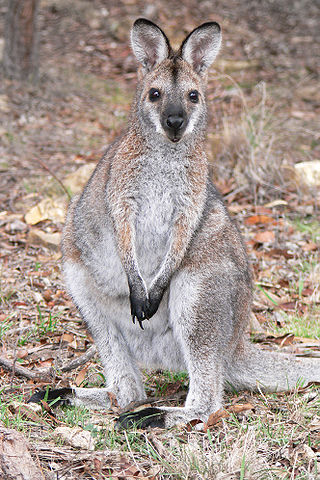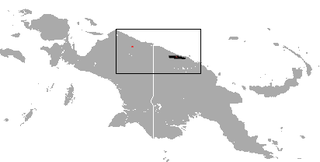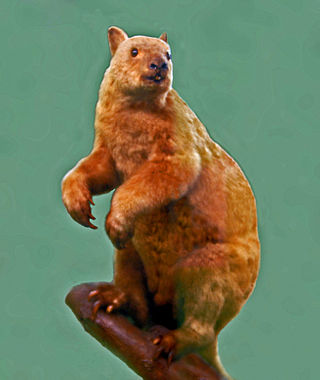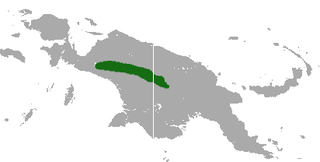
Tree-kangaroos are marsupials of the genus Dendrolagus, adapted for arboreal locomotion. They inhabit the tropical rainforests of New Guinea and far northeastern Queensland, along with some of the islands in the region. All tree-kangaroos are considered threatened due to hunting and habitat destruction. They are the only true arboreal macropods.

Macropodidae is a family of marsupials that includes kangaroos, wallabies, tree-kangaroos, wallaroos, pademelons, quokkas, and several other groups. These genera are allied to the suborder Macropodiformes, containing other macropods, and are native to the Australian continent, New Guinea and nearby islands.

The dingiso, also known as the bondegezou or bakaga, is an endangered, long-tailed marsupial found only in mountain forests on the west of the island of New Guinea. It is a species of tree-kangaroo, which are mammals native to Australia and New Guinea that feed on leaves or other plant matter. It belongs to the macropodid family (Macropodidae) with kangaroos, and carries its young in a pouch like most other marsupials. Though sacred to the local Moni people, it is still threatened by hunting and habitat loss.

Matschie's tree-kangaroo, also known as the Huon tree-kangaroo is a tree-kangaroo native to the Huon Peninsula of northeastern New Guinea island, within the nation of Papua New Guinea. Under the IUCN classification, Matschie's tree-kangaroo is an endangered species. The scientific name honours German biologist Paul Matschie. The indigenous population refers to it as a Boongarry.

Goodfellow's tree-kangaroo, also called the ornate tree-kangaroo, is an endangered, long-tailed, bear-like mammal native to rainforests of New Guinea. Like most tree-kangaroos, it lives in the treetops and feeds on leaves or other plant matter. It belongs to the macropod family (Macropodidae) along with kangaroos, and carries its young in a pouch like other marsupials. Its main threats are habitat loss and hunting. There are two subspecies: D. g. goodfellowi and D. g. buergersi.
The Torricelli Mountains are a mountain range in Sandaun Province, north-western Papua New Guinea. The highest peak in the range is Mount Sulen at 1650 meters. The Bewani Mountains are located to the west, and the Prince Alexander Mountains are located to the east. To the north, the mountains slope down to the Pacific Ocean, and to the south lies the basin of the Sepik River. Named after the Italian physicist and mathematician Evangelista Torricelli during the German colonial period.

Lumholtz's tree-kangaroo is a rare, long-tailed marsupial found in rainforests in northeastern Australia. Like most tree-kangaroos, it lives alone in trees and feeds on plant matter. It belongs to the macropod family (Macropodidae) with kangaroos, and carries its young in a pouch like other marsupials. It is threatened by climate change and diseases, and is found in the hilly, fertile Atherton Tableland near Cairns in north east Queensland.

Bennett's tree-kangaroo is a large tree-kangaroo. Males can weigh from 11.5 kg up to almost 14 kg, while the females range between about 8 to 10.6 kg. They are very agile and are able to leap 9 metres (30 ft) down to another branch and have been known to drop as far as 18 metres (59 ft) to the ground without injury.

The golden-mantled tree-kangaroo is a critically endangered, furry, bear-like mammal found only in mountain rain forests on the island of New Guinea. Like other tree-kangaroos, it lives in trees and feeds on plant matter. It belongs to the macropod family (Macropodidae) with kangaroos, and carries its young in a pouch like other marsupials. The range is restricted to two small mountain areas in the north and it is threatened by hunting and habitat loss.

Doria's tree-kangaroo is a long-tailed, furry, bear-like mammal found only in tropical mountain forests on the island of New Guinea. It is one of the largest tree-kangaroos, living alone in trees and active at night to feed on leaves or fruit. It belongs to the macropod family (Macropodidae) with kangaroos, and carries its young in a pouch like other marsupials. Threats include hunting and habitat loss.

The grizzled tree-kangaroo is a furry, long-tailed, bear-like mammal native to tropical rainforests on the island of New Guinea. Like most tree-kangaroos, it lives in trees and eats leaves, fruit, and bark. It is a member of the macropod family Macropodidae with kangaroos, and carries its young in a pouch like other marsupials. The tree-kangaroo is uncommon and threatened by hunting and habitat loss. It is found in foothill forests of northern and western New Guinea and is indigenous to some of the offshore islands.

The tenkile, also known as Scott's tree-kangaroo, is a species of tree-kangaroo in the family Macropodidae. It is endemic to a very small area of the Torricelli Mountains of Papua New Guinea. Its natural habitat is subtropical or tropical dry forests. It is threatened by habitat loss and by hunting. The tenkile is listed as endangered due to hunting and logging activities in Papua New Guinea. The tenkile is hunted for its meat, and has been a main protein source for the local tribespeople. The local human population has increased in recent years, increasing demand for tenkile meat. Additionally, tenkiles are poached for their fur and are captured and sold as a part of the illegal pet trade. Domesticated dogs also hunt tenkiles. Deforestation in Papua New Guinea affects all tree-kangaroos, and industrial logging that occurs in the Torricelli Mountain Range decreases the species' already restricted habitat. The Torricelli Mountain Range faces additional deforestation due to the timber industry, and the production of coffee, rice and wheat.

The ursine tree-kangaroo is a long-tailed, furry, bear-like mammal found only in tropical forests on the island of New Guinea. Slightly larger than a cat, it lives alone in trees and is active at night to feed on leaves and fruit. It belongs to the macropod family (Macropodidae) with kangaroos, and carries its young in a pouch like other marsupials. It has a small range in northwestern New Guinea and is threatened by habitat loss and hunting. Other common names for this species include the black tree-kangaroo, the Vogelkop tree-kangaroo and the white-throated tree-kangaroo.

The brown dorcopsis, also known as the brown forest wallaby, is a species of marsupial in the family Macropodidae. It is endemic to the lowlands of West New Guinea and the nearby Indonesian islands in West Papua of Misool, Salawati, and Yapen.

Seri's tree-kangaroo is a species of tree-kangaroo native and endemic to montane forests of west-central New Guinea. Seri's tree-kangaroo was originally considered to be a subspecies of Dendrolagus dorianus, but was elevated to species in 2005 by Groves.

Dendrolagus notatus, the ifola or ifola tree kangaroo, is a species of marsupial in the family Macropodidae. It is endemic to Papua New Guinea where it is found in high elevations of the central mountains. It is threatened by habitat loss and hunting for food with dogs by local people. The species is usually considered a subspecies of Dendrolagus dorianus but has recently been considered as a separate species by Helgen in 2007.

The Wondiwoi tree-kangaroo is a critically endangered, bear-like mammal native to tropical mountain forests on the island of New Guinea in Western Papua. Elusive and rare, it was considered extinct until rediscovery in 2018. It is a species of tree-kangaroo, a group of long-tailed, bear-like animals native to Australia and New Guinea that mostly live in trees and feed on plant matter. Tree-kangaroos belong to the macropod family (Macropodidae) with kangaroos, and carry their young in a pouch like most other marsupials. The Wondiwoi tree-kangaroo is likely threatened by hunting, and is known only from remote mountains on the Wondiwoi Peninsula in northwest New Guinea.

The Vogelkop–Aru lowland rain forests is a tropical moist forest ecoregion in Indonesia. The ecoregion covers the peninsular lowlands of western New Guinea, along with the Aru Islands and other nearby islands.

The Vogelkop montane rain forests is a tropical moist forest ecoregion in western New Guinea. The ecoregion covers the mountains of western New Guinea's Bird's Head and Bomberai peninsulas.



















